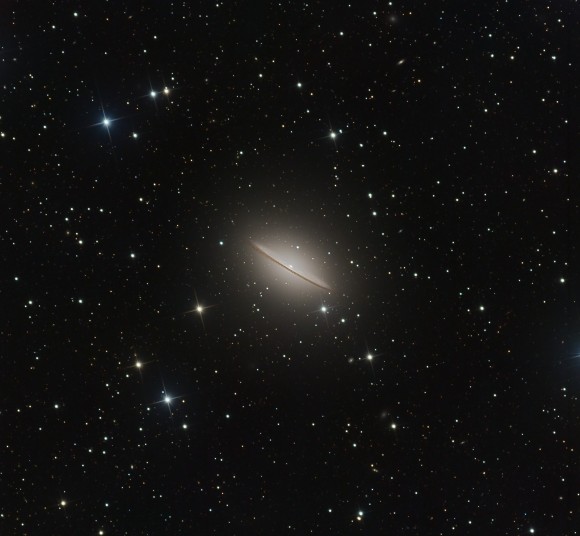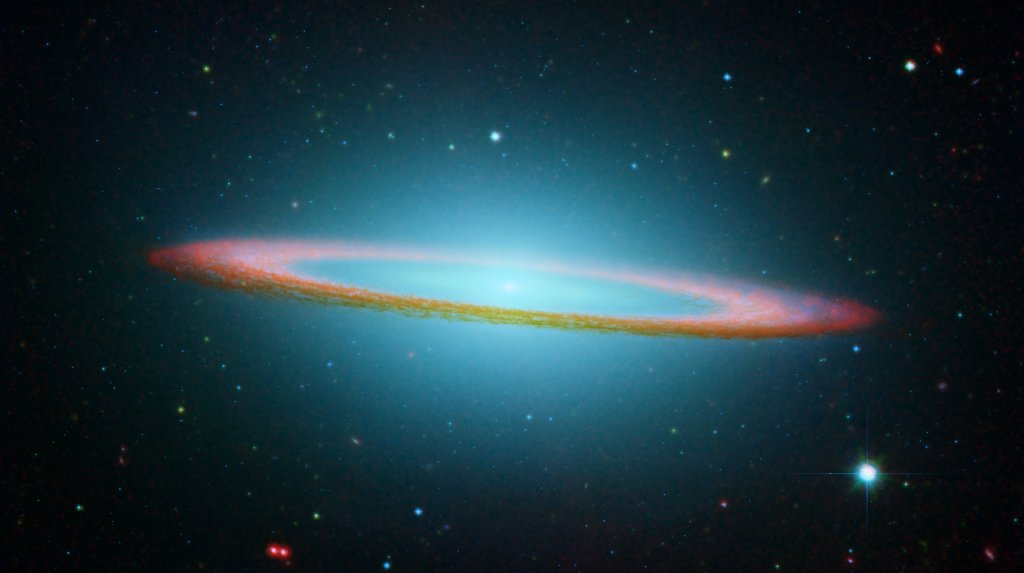

This is the Sombrero Galaxy (also known as M104 or NGC 4594), it is an unbarred spiral galaxy found in the constellation Virgo. The galaxy itself, which we are viewing almost perfectly edge-on, is about 60,000 light-years across. From this vantage point, one of the most prominent features of the Sombrero Galaxy is its magnificent dust lane. This thick band of dust makes up the rim of the sombrero. In contrast, the extremely bright starry bulge engulfs the galaxy with the diffuse glow of billions of stars. The above image was taken by Ian Sharp at the Siding Spring Observatory in Australia. In it, we can clearly see the famous bands of dust. He used 12 hours of Luminance and 5 hours each on R, G and B channels. See more great images here.

The Sombrero galaxy is located some 28 million light-years away from our own little planet. In its center, there is a massive black hole, which scientists believe is billions of time more massive than our Sun. To capture this amazing image above, the Hubble Space Telescope teamed up with NASA’s Spitzer Space Telescope. The picture is composed of four images taken at 3.6 (blue), 4.5 (green), 5.8 (orange), and 8.0 (red) microns. This rendering of the galaxy shows that the Sombrero galaxy is slightly warper, which is generally the result of an encounter with another galaxy and the gravitational forces that result.

The above image helps you clearly see why it is important to have a good telescope. Looking at the top image, how many stars can you see? Admittedly, there are a fair number; however, it only takes a momentary glance at the bottom image to tell that, if you only ever look at the top image, then you are missing a lot of what’s out there. The bottom image is another one from Hubble, and it shows how telescopes are literally the gateway to the universe. Peer through Hubble, and suddenly, a blurry blob of light transforms into a delicate galaxy, while another ambiguous white hue separates into a cluster of stars.

This image is astounding as a result of its stunning clarity, and it is another example of the improvements that can be made to astronomical images through technology. Obviously this image has been through a bit of processing in order to make its features more recognizable. Here, the Hubble Space Telescope’s archival image data has been reprocessed in order to reduce the amount of glare in the image. This process reveals the thin bands of dust that makeup the Sombrero and give it its unique look.

Okaay, so this final image is super weird. But that’s only because the image is in X-ray. This Chandra X-ray image shows hot gas in the galaxy and point sources that are a mixture of galaxy members and background objects. According to the release, “in this image, Chandra low energy X-rays (0.3-1.5 keV) are color-coded orange and high energy X-rays (1.5-7.0 keV) are in blue. The Chandra image shows hot gas in the Sombrero galaxy and point sources that are a mixture of galaxy members and background objects.”
Learn more about the Sombrero Galaxy in the video below:
